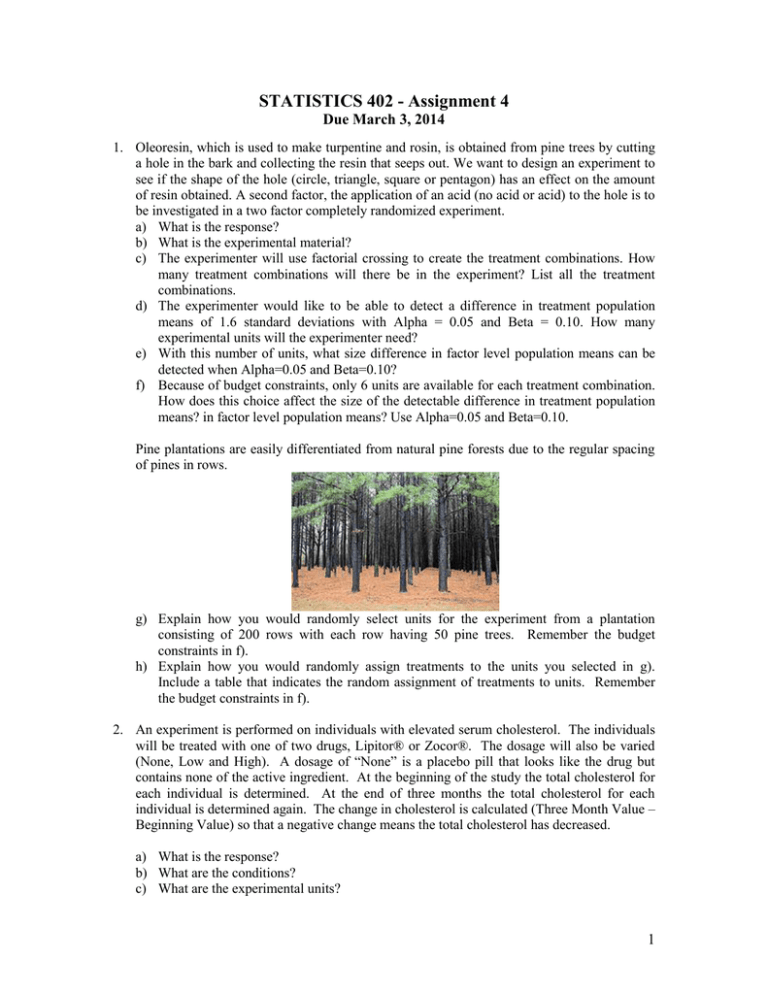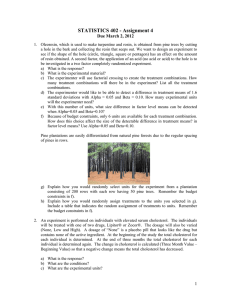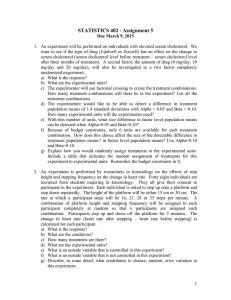STATISTICS 402 - Assignment 4 Due March 3, 2014
advertisement

STATISTICS 402 - Assignment 4 Due March 3, 2014 1. Oleoresin, which is used to make turpentine and rosin, is obtained from pine trees by cutting a hole in the bark and collecting the resin that seeps out. We want to design an experiment to see if the shape of the hole (circle, triangle, square or pentagon) has an effect on the amount of resin obtained. A second factor, the application of an acid (no acid or acid) to the hole is to be investigated in a two factor completely randomized experiment. a) What is the response? b) What is the experimental material? c) The experimenter will use factorial crossing to create the treatment combinations. How many treatment combinations will there be in the experiment? List all the treatment combinations. d) The experimenter would like to be able to detect a difference in treatment population means of 1.6 standard deviations with Alpha = 0.05 and Beta = 0.10. How many experimental units will the experimenter need? e) With this number of units, what size difference in factor level population means can be detected when Alpha=0.05 and Beta=0.10? f) Because of budget constraints, only 6 units are available for each treatment combination. How does this choice affect the size of the detectable difference in treatment population means? in factor level population means? Use Alpha=0.05 and Beta=0.10. Pine plantations are easily differentiated from natural pine forests due to the regular spacing of pines in rows. g) Explain how you would randomly select units for the experiment from a plantation consisting of 200 rows with each row having 50 pine trees. Remember the budget constraints in f). h) Explain how you would randomly assign treatments to the units you selected in g). Include a table that indicates the random assignment of treatments to units. Remember the budget constraints in f). 2. An experiment is performed on individuals with elevated serum cholesterol. The individuals will be treated with one of two drugs, Lipitor® or Zocor®. The dosage will also be varied (None, Low and High). A dosage of “None” is a placebo pill that looks like the drug but contains none of the active ingredient. At the beginning of the study the total cholesterol for each individual is determined. At the end of three months the total cholesterol for each individual is determined again. The change in cholesterol is calculated (Three Month Value – Beginning Value) so that a negative change means the total cholesterol has decreased. a) What is the response? b) What are the conditions? c) What are the experimental units? 1 d) Why is random assignment of treatments to the experimental units in this experiment important? Be specific and be sure your answer deals with this experiment. Placebo (None) Low High Lipitor® –13 –26 –19 –25 –9 –23 –25 31 25 –18 –22 9 –5 –23 –8 23 –5 36 –12 –46 –6 –23 –41 –40 –32 –65 –8 –59 –26 27 –28 –34 –52 –40 –1 –44 –8 –12 –39 –27 –32 –13 –18 –55 13 6 –43 –37 –56 –61 –3 –49 –58 –84 Zocor® 27 6 –17 –19 –24 –22 –19 –10 –34 11 –16 –4 –19 –16 19 14 14 18 –25 23 –48 –27 –79 –61 6 –38 –27 –21 18 –40 –46 –17 –33 –42 –23 –32 –79 –29 –38 –32 –36 –22 –17 –12 –102 –41 –87 –64 –16 –39 –51 –36 –48 –20 e) Give the full model for these data. Be sure to define all the terms in the model within the context of the problem. f) Test the hypothesis that all the treatment effects are zero against the alternative that at least one is not zero. Be sure to give an appropriate null and alternative hypothesis using the notation from your answer to e). Report the value of the appropriate test statistic, Pvalue, decision, reason for the decision and a conclusion within the context of the problem. g) Test the hypothesis that all the drug effects are zero against the alternative that at least one is not zero. Be sure to give an appropriate null and alternative hypothesis using the notation from your answer to e). Report the value of the appropriate test statistic, Pvalue, decision, reason for the decision and a conclusion within the context of the problem. h) Where are the statistically significant differences in drug sample means? Support you answer statistically. i) Test the hypothesis that all the dosage effects are zero against the alternative that at least one is not zero. Be sure to give an appropriate null and alternative hypothesis using the notation from your answer to e). Report the value of the appropriate test statistic, Pvalue, decision, reason for the decision and a conclusion within the context of the problem. j) Where are the statistically significant differences in dosage level sample means? Support you answer statistically. k) Are there any interaction effects that are different from zero? Be sure to give an appropriate null and alternative hypothesis using the notation from your answer to e). Report the value of the appropriate test statistic, P-value, decision, reason for the decision and a conclusion within the context of the problem. l) Construct an interaction plot. Comment on the plot and what it tells you about the interaction between the two factors. Be specific and be sure your answer deals with the context of this experiment. m) Based on the analysis of these data, what drug and dosage would you recommend for people similar to the people used in the experiment? n) Construct plots of residuals versus the levels of the two factors. Describe the plots and indicate what this tells you about the Fisher conditions necessary for the analysis of variance. o) Construct plots of the distribution of residuals. Describe each of the plots in the distribution of residuals. Indicate what this tells you about the Fisher conditions necessary for the analysis of variance. Turn in the JMP output that you have used to answer the questions. 2





